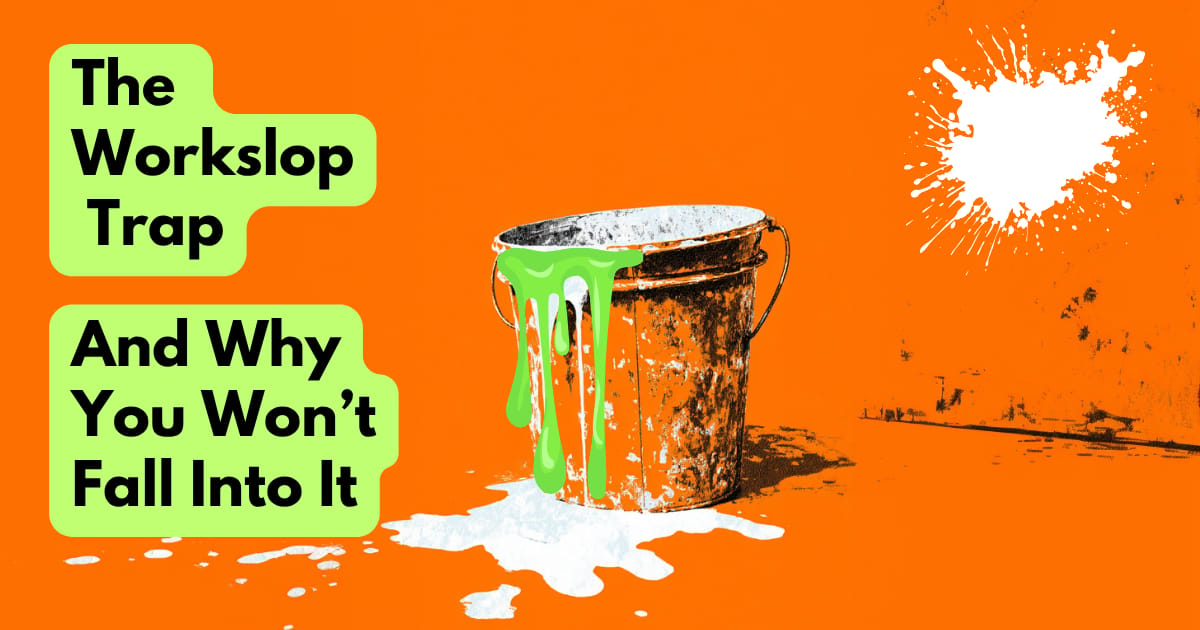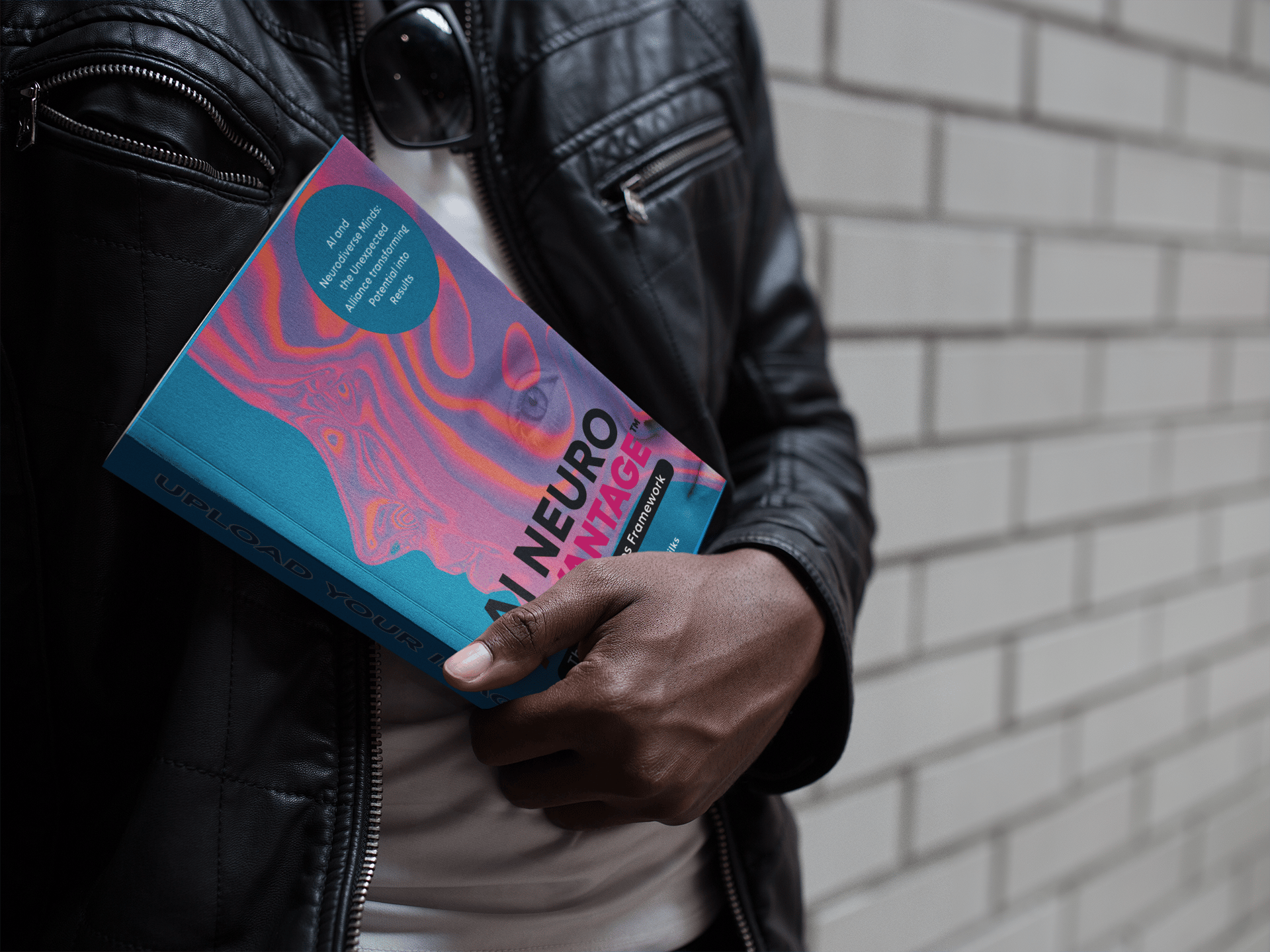- Brain Doubles Newsletter
- Posts
- The Workslop Trap
The Workslop Trap
And Why You Won't Fall Into It.

Yesterday I asked several LLM’s to evaluate how I use them. One of those proficiency assessment prompts making the rounds.
Turns out I'm in the top 15-5% of users, depending on which one you ask.
Not because I'm technical. Not because I know any magic prompts. But because I actually engage with it—iteratively, conversationally, intellectually, like it's a thinking partner instead of a magic answer box.
Which brings me to the new term everyone's talking about: workslop.
What Is Workslop?
Harvard Business Review researchers just coined this word to describe something you've probably already experienced: AI-generated content that looks polished but says absolutely nothing.
You know the feeling. Someone sends you a report. Perfect formatting. Proper headers. Eloquent sentences. You start reading and... wait, what? You read it again. By the third pass, it hits you: this document is beautiful and completely useless.
That's workslop. And it's everywhere.
Forty-one percent of workers say they've received it in the past month. Each instance costs nearly two hours of rework—not because the format needs fixing, but because someone has to do the actual thinking that should have been done in the first place.
This helps explain why 95% of organizations report seeing zero return on their AI investments, even as AI use has doubled in workplaces since 2023. All this activity, all this adoption, and little to show for it.
The Lazy Binary
Here's where it gets interesting. Too many people think there are only two options: avoid AI and stay "pure," or use AI and produce garbage.
That's not just wrong—it completely misses what's actually happening.
The researchers are right about one thing: workslop happens when people treat AI like a shortcut. Put in a prompt, get out some words, hit send. No thinking required. Just automation.
But here's what they're documenting: lazy engagement produces lazy results. If you abdicate your thinking and just accept whatever gets generated, you create polished emptiness that makes more work for everyone else.
Of course you do.
What Actually Makes the Difference
Back to that proficiency assessment. Here's what it picked up on—not technical skill, but how I interact.
When I'm working on something, I don't drop in a prompt and walk away. I start a conversation. I explain what I'm trying to do and why it matters. I share where I'm stuck. Then I work with what comes back—pushing, refining, saying "no, that's not what I mean, let me try again."
It's iterative. It's back-and-forth. And here's the thing: I'm pouring my thinking into every step of the process. My judgment. My expertise. My understanding of what actually needs to happen.
The AI isn't doing my thinking. It's helping me articulate my thinking in real time.
The Cognitive Signature Effect
There's something I talk about in my book—this idea of a cognitive signature. How you naturally think, approach problems, handle uncertainty... all of that shapes how AI responds to you.
Some people are what I call Thread Pullers—they follow fascinating tangents and circle back around. Others are Ocean Boilers who need to see everything at once before they can start. Some think through dialogue. Others through structured planning.
When you show up authentically—when you engage with your natural thinking patterns instead of trying to game some system—the AI adapts. It becomes the kind of partner that works with your specific rhythm.
That's what those proficiency assessments are really measuring. Not whether you know the right tricks, but whether you're genuinely engaged.
The Real Divide
So here's what actually separates productive AI collaboration from workslop:
One person uses AI to help express ideas that are already theirs. To structure thinking they've already done. To refine concepts they genuinely understand. They're in constant dialogue—verifying information, pushing back when something doesn't sound right, shaping and reshaping until it says what they actually mean.
Another person wants a homework assignment they can outsource. They want the appearance of work without doing any thinking. They're looking for shortcuts, not support.
Both might produce polished documents. But only one carries actual thinking, judgment, and substance. The other is exactly what the researchers describe: a burden shifted to everyone else, who now have to do the cognitive work that should have been done in the first place.
Why This Matters
This matters especially for what I call Brain Doubles—where AI provides complementary cognitive support for neurodivergent thinkers. Done well, it amplifies your natural thinking patterns. It helps you capture elusive thoughts, structure scattered ideas, express insights that are genuinely yours but hard to communicate.
Done lazily? Just another path to workslop.
The difference isn't the technology. It's whether you're still the one doing the thinking.
The Accountability Test
Can you explain the reasoning behind what you're sending? Have you verified the information? Could you defend the ideas in a conversation, or are you just forwarding AI output you haven't actually engaged with?
If you can't stand behind it—that's workslop. And people notice.
Not because they're anti-AI. But because they can tell when someone has abdicated responsibility for actually thinking.
The Better Path
The conversation shouldn't be "AI or no AI."
It should be: are you using these tools as a thinking partner or a thinking replacement?
Are you iterating? Questioning? Refining? Are you bringing your expertise and judgment into the process? Are you treating this as collaboration, or as automation?
Because that's what determines whether you create something valuable or just more workslop clogging everyone's day.
The technology isn't the problem. The abdication is.

COMING SOON! IT’S BEEN A LONG JOURNEY BUT WE’RE ALMOST THERE :)
The AI@Work Brief
1. The Death of the 'Ad Campaign' with WPP and Google
The Gist: The massive new five-year strategic partnership between WPP and Google means marketing is moving from slow, seasonal campaigns to real-time, personalized content factories. WPP is embedding Google's latest generative AI models (like Gemini and Veo) into its operating system. This lets brands instantly generate and deploy millions of personalized ads, videos, and messages tailored for individual customers. This shift has already delivered up to 70% efficiency gains in asset creation.
Source: WPP and Google joint announcement, Oct 14, 2025.
2. Autonomous AI Agents Start Doing Your Employees' Jobs
The Gist: OpenAI has fully productized the creation of specialized AI workers, or "agents," that can complete entire business processes autonomously. The launch of Agent Builder and Agent Kit allows non-technical teams to visually design multi-step workflows. For example, an agent could autonomously triage a customer support ticket, check inventory, and update the CRM system—all without human intervention. This move from AI assistance to AI executionis where the major productivity gains for businesses will be realized.
Source: OpenAI DevDay announcement, Oct 6, 2025.
The Gist: New research from the Harvard Business Review coined the term "workslop." This refers to low-quality, AI-generated content (like polished but substance-less reports) that is clogging up workflows and actually decreasing productivity. The study found that 40% of employees report encountering this output, costing organizations millions annually in necessary rework. The core business takeaway is that ROI from GenAI requires guardrails and training to ensure AI is a true accelerator, not a source of corporate waste.
Source: Harvard Business Review research, late September 2025.
The newsletter for savvy professionals mastering hybrid human-AI intelligence.